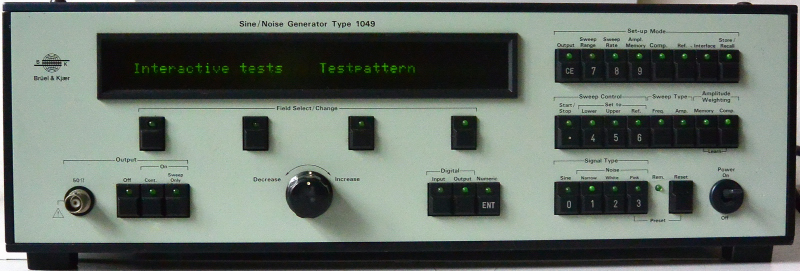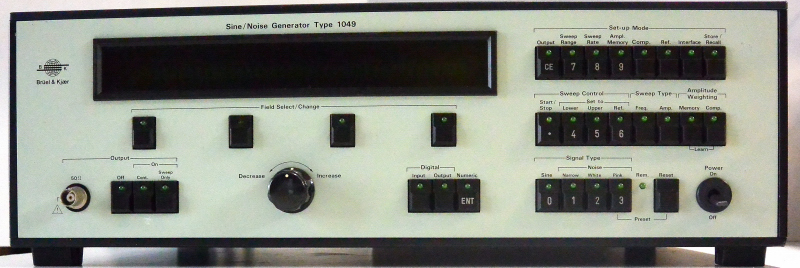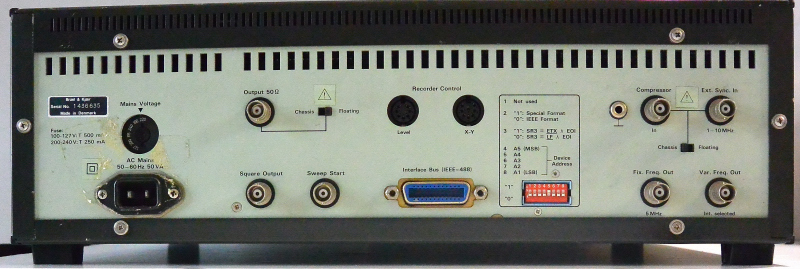
- AI Artificial intelligence
- App
- Artificial intelligence AI Video generators
- Computer - Cell phone
- Electronic Brand
- Electronic Flea Market
- GPS - GPRS
- HAM Radio
- I.C. & functions
- Instruments
- Instruments - Funcions
- Internet
- LAN
- Optics
- Phones
- Photography
- Software
- Solar panels
- Tablet
- Tracking
- Video - TV
- Weather Stations
- Web - Best sites


![]() Bruel & Kjaer Sine/Noise Generator 1049
Bruel & Kjaer Sine/Noise Generator 1049
Rating : 9.3
| Evaluation | N. Experts | Evaluation | N. Experts |
|---|---|---|---|
| 1 | 6 | ||
| 2 | 7 | ||
| 3 | 8 | ||
| 4 | 9 | ||
| 5 | 10 |
10 pts from Harrier2
| Sign up to vote this object, vote his reviews and to contribute to Tiiips.Evaluate | Where is this found? |
| "Descrizione" about Bruel & Kjaer Sine/Noise Generator 1049 Review Consensus 10 by Harrier2 (1055 pt) | 2022-Oct-17 21:19 |
| Read the full Tiiip | (Send your comment) |
The Bruel Kjaer 1049 as well as the 1051 has the following functions :

- 0,2 to 200000 Hz sine generators with frequency resolution down to 1 mHz and clock stability better than +/- 5 x 10-8/year
- Calibrated output from 100 uV to 5 V with less than -96 db harmonic and spurious distortion
- Six-decade frequancy sweep in one continuous range with selectable lower and upper limits.
- Choice of linear and logarithmic frequency sweep with sweep rates from 0,001 Hz to 999,9 kHz/s and 0,001 mDec to 2 Decs respectively
- Single, repetitive (l-99) and continuous sweep modes with 0,01 to 100,0 s pause between sweeps
- 1024 point amplitude memory, with automatic amplitude interpolation, for preconditioned test excitation
- 40 character, alphanumeric, line display for monitoring and setting-up of frequency and amplitude sweep parameters etc.
- 9 set-ups for recalling frequently repeated excitation test and measurement sequence
- Versatile IEEE/IEC bus for remote control and digital output of data
USES:
- Precision ATE signal generators for use in computer based test systems, requiring a high accuracy, low distortion excitation source
- Semi and fully automatic test and calibration of electrical and mechanical equipment for product design, development, production and service
- Swept-frequency electro- and building-acoustic measurements; vibration testing of mechanical components; plus audiological research etc.
- Storage of amplitude weightings for equalizing non-flat loudspeaker, vibration exciter responses etc.
- Remote control of Level, X-Y and Graphic Recorders for synchronous recording of amplitude, phase and distortion responses
- Choice of linear and logarithmic frequency sweep with sweep rates from 0,001 Hz to 999,9 kHz/s and 0,001 mDec to 2 Dec/s respectively
- Single, repetitive (l-99) and continuous sweep modes with 0,O1 to 100,0 s pause between sweeps
- 1024 point amplitude memory, with automatic amplitude interpolation, for preconditioned test excitation
- 40 character, alphanumeric, line display for monitoring and setting-up of frequency and amplitude sweep parameters etc.
- 9 set-ups for recalling frequently repeated excitation test and measurement sequences
- Versatile IEEE/IEC bus for remote control and digital output of data
FEATURES:
- 0,2 to 200000 Hz, sine generators with frequency resolution down to 1 mHz and clock stability better than 5 x 1
- Calibrated output from 100 to 5V with less than -96 dB harmonic and spurious distortion
- Six-decade frequency sweep in one continuous range with selectable lower and upper limits
ADDITIONAL FEATURES 1049:
- Narrow-band random, white and pink noise modes
- Logarithmic amplitude sweep with sweep rates from 0,O1 to 999 dB/s
- 118 dB compressor circuit for active control of sound or vibration level at exciter output
- Automatic learn mode for amplitude memory, via compressor

The B&K Types 1049 and 1051 are two microprocessor-based sine generators which combine today’s needs of increased spectral purity, frequency resolution and stability with ease of use and versatility. Their wide frequency coverage from 0,2 Hz to 200 kHz, with amplitude linearity and frequency resolution of 0,05 dB and 1 mHz, make them suitable for numerous applications in electronic engineering, as well as in acoustics and vibration measurements. Linear and logarithmic sweep ranges, each with their own user-presettable lower and upper limits may be chosen, including extended linear sweeps from 0,001 Hz to 200 kHz. Single, repetitive and continuous sweep modes are also included and the time for each individual sweep is automatically calculated and displayed.
Outputs levels from 100 to 5 V RMS may be chosen to 3 digits, permitting either a constant amplitude or an amplitude-weighted, frequency sweep to be obtained. With the latter up to 1024 amplitudes may be stored, which enable the Generators to simulate the output of record reproducer pick-ups, tape heads and electrical circuits etc. Also, equalization characteristics can be stored for maintaining a constant sound pressure or vibration output with loudspeakers and vibration exciters.
All functions and parameters may be selected or entered by the front panel pushkeys or via the IEEE/IEC digital interface bus of the Generators. In addition, there is an analogue “speeder” knob for fast and precise continuous adjustment of parameters. Front panel set-up conditions are indicated on a 40-character line display, from which as many as four functions and their individual parameters may be monitored simultaneously.
If desired, nine sets of front panel set-up conditions may be stored and instantly recalled for performing frequently used excitation test and measurement sequences, as is normally called for in service and production testing of products. For automatic plotting of swept-frequency measurements and analyses, special provision is made for synchronizing level and X- Y recorders. Alternatively, where an IEEE/IEC system controller is used for automatic control of the Generators they may be coupled with a digital plotter.
In addition to the above, the Type 1049 has a number of extra facilities. These include a logarithmic amplitude sweep, as well as narrow-band random, white and pink noise outputs. Also, a compressor circuit is built in as an alternative means of obtaining a constant sound or vibration level output when a loudspeaker or vibration exciter is employed with the generator. In this case, however, external feedback is employed to provide active regulation of the generator output which has the benefit that it automatically takes into account the response of the exciter under actual test conditions.
Description
A simplified block diagram of the B&K Generators Types 1049 and 1051 is shown in Fig.1. They have 6 main sections, namely a Master Clock, a Digital Frequency Synthesizer, a Phase Lock Synthesizer, a Sweep Synthesizer and an Output Section, all of which operate under the guidance of a Microprocessor Section which takes care of the user communication via the front panel controls and IEEE/IEC interface of the Generators. In addition, Type 1049 features a Noise Generator and Compressor, which greatly increase its range of applications, especially for acoustic and vibration measurements.
Frequency Synthesizer
The Generators employ a heterodyne synthesis technique where a 500 kHz fixed frequency is mixed with a 500 to 700 kHz variable frequency to produce an 0,001 Hz to 200 kHz swept-frequency, sine-wave output with frequency resolution of 1 mHz. The 500 kHz fixed frequency is obtained from a Master Clock, while the 500 to 700 kHz variable frequency is derived from the 5 to 7 MHz output of a Phase Lock Synthesizer.
The Master Clock is based on a stable 10 MHz crystal oscillator whose relative accuracy is transferred to the output frequency. If an even greater accuracy is required the internal oscillator can be phase locked with an external reference which may be coupled to an External Synchronization

For a 5 to 7 MHz variable frequency proportional to the generator output frequency, a 31 bit frequency control output from the Sweep Synthesizer is utilized. To achieve a wide sweep range while maintaining a high accuracy and resolution, the Sweep Synthesizer output is split into two components. The lowest 23 bits are used to produce a 100 to 200 kHz variable control frequency proportional to the Hz and mHz frequency setting of the Generators, while the remaining 8 bits are used to produce a 49,9 to 69,9 MHz control frequency proportional to the kHz setting.
The respective control frequencies are generated by a digital synthesis and a divide by “N” phase lock loop. They are then summed by another phase lock loop to produce a 50 to 70 MHz control frequency which after application to a 1O:1 frequency divider in the Phase Lock Synthesizer is fed to the Output Section where the final stages of frequency conversion take place. The use of two phase lock loops for producing 50 to 70 MHz control frequency, ensures that phase noise is kept to a minimum.
Output Section
From the Phase Lock Synthesizer the 5 to 7 MHz control frequency is applied to a second 10:1 frequency divider which is included at the input of the mixer stage of the Output Section. The output is then mixed with the 500 kHz output of the Master Clock to produce a sine-wave signal whose frequency corresponds directly to the frequency indicated on the display of the Generators. For removing unwanted sideband components in the mixed signal, a 280 kHz low-pass filter is employed.
Before application to the outputs of the Generators the filtered sine-wave signal is fed to an attenuator and amplifier for amplitude conditioning. The output attenuator gives an overall attenuation of 16 bits enabling the fraction and exponent of the output level to be accurately set within 3 digits from 100 to 5,00 V RMS via the front panel controls and interface bus of the Generators.
The Output Amplifier provides two low impedance signal outputs, which are made available at a BNC socket on the front and rear panels. These may be matched with 50 signal lines and to suit different test system grounding requirements, may be isolated or connected to chassis by means of a slider switch on the rear panel. See Fig.3.

In the design of the Generators, particular attention has been paid to obtaining very low signal distortion and good amplitude linearity. As indicated in Fig. 4 the maximum harmonic and spurious distortion is guaranteed better than -96 dB at frequencies between 20 Hz and 20 kHz, with second and third harmonic distortion components typically -1l0dB down at 1 kHz.

The amplitude linearity of the output is better than +/-0,05 dB at frequencies between 20 Hz and 20 kHz, decreasing to +/- 0,2 dB at 0,2 Hz and 200 kHz. At lower frequencies the amplitude falls by 20 dB per decade, but by utilizing the “Memory Learn” function of the Generators to maintain a constant output level of 300 mV or less, a flat amplitude characteristic can be maintained at all frequencies down to 0,001 Hz.
Sweep Synthesizer
The Sweep Synthesizer includes a ramp register which produces a 31 bit output representing the frequency setting of the Generators. The frequency may be set by an input either from the front panel keyboard or via the interface bus of the Generators. For a frequency sweep, however, an internal clock signal is used, enabling either “Linear” or “Logarithmic” frequency sweeps to be chosen with sweep rates from 0,001 Hz/s to 999,9 kHz/s and 0,001 mDecade/s to 2 Decade/s, respectively.
With linear and logarithmic frequency sweeps, six or more complete frequency decades can be covered in a single range. The logarithmic sweep range extends from 0,2 Hz up to 200 kHz, while the linear sweep range is from 0,001 Hz up to 200 kHz, however, either can be independently set to any lower or upper frequency limit within these ranges if so desired.
In addition to the above, “Up”, “Down”, “Up/Down”, “Single”, “Repetitive” (1 to 99) and “Continuous” sweeps modes may be chosen. Also there is a “Pause” function whereby a preset delay of between 0 and 100 s may be included between each consecutive sweep.
A convenient feature is that the Generators automatically compute the time for a single sweep. The sweep time is indicated directly on the front panel display and automatically takes into account the particular frequency limits and sweep rate chosen. With single and repetitive Up/Down sweeps a minimum sweep time of 8 ms can be achieved, while with sweeps including pause or single sweeps in one direction, sweep times as short as 62,5 are possible.
Because the frequency sweep of the 1049 and 1051 is rate based a higher sweep accuracy can be maintained. With generators which are programmed with respect to time the sweep accuracy is generally lower, particularly with logarithmic sweeps.
Amplitude Memory
Besides a ramp register for frequency synthesis, the Sweep Synthesizer contains an amplitude register for controlling the Output Section Attenuator.
For manual setting of the output level, the amplitude register accepts a numeric input from the front panel keyboard or a digital input applied over the interface bus of the Generators. The input may be applied directly to the amplitude register or, if the “Memory Learn” function is used, via the internal memory of the Generators. In the latter case, up to 1024 amplitudes can be stored for successive frequencies within any desired frequency range of the Generators, and when recalled enable almost any type of single or repetitive, amplitude weighted, frequency sweep to be generated.
The “Memory Learn” function is of particular benefit for swept frequency sound and vibration measurements. When one of the Generators is employed to drive a loudspeaker or vibration exciter, for example, its output level can be weighted according to the dynamic response of the loudspeaker or vibration exciter so that a constant sound pressure or vibration level output is maintained over the entire frequency range of interest.
To save entry of each individual level manually, the “Memory Learn” function includes automatic amplitude interpolation between consecutive amplitudes input. Alternatively, amplitudes may be entered as a voltage signal via the Compressor Input of the 1049.
| Sign up to vote this object, vote his reviews and to contribute to Tiiips.EvaluateClose | (0 comments) |
Read other Tiiips about this object in __Italiano (1)
Brand: I.C.: Last update: 2022-01-25 11:03:07 | Function: Indicative price: |



